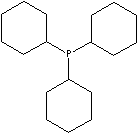| TRICYCLOHEXYL PHOSPHINE | ||
|
PRODUCT IDENTIFICATION |
||
| CAS NO. | 2622-14-2 |
|
| EINECS NO. | 220-069-2 | |
| FORMULA | (C6H11)3P | |
| MOL WT. | 280.43 | |
| H.S. CODE | ||
|
TOXICITY |
||
| SYNONYMS | Triciclohexilfosfina; Tricyclohexylphosphine; | |
|
DERIVATION |
|
|
|
CLASSIFICATION |
|
|
|
PHYSICAL AND CHEMICAL PROPERTIES |
||
| PHYSICAL STATE | white to yellow crystalline powder | |
| MELTING POINT | 78 - 83 C | |
| BOILING POINT |
|
|
| SPECIFIC GRAVITY | ||
| SOLUBILITY IN WATER | ||
|
SOLVENT SOLUBILITY |
||
| pH | ||
| VAPOR DENSITY | ||
| AUTOIGNITION |
|
|
| NFPA RATINGS | ||
|
REFRACTIVE INDEX |
||
| FLASH POINT | ||
| STABILITY | Stable under ordinary conditions. | |
| GENERAL DESCRIPTION & APPLICATIONS | ||
| Phosphine, also called Hydrogen Phosphide, PH3, is a colourless, poisonous, spontaneously flammable gas, with a disagreeable, garlic-like odour; melting point -133.5 C, boiling point -87.4 C. Phosphine is manufactured by the hydrolysis of metal phosphides, by the electrolysis of phosphorus in the presence of hydrogen, or by the phosphorus-steam reaction. Phosphine has the structure of ammonia (NH3) but with phosphorus in place of nitrogen. It is slightly soluble in cold water and soluble in alcohol. Phosphine is less soluble in water than ammonia. Phosphine is used in the synthesis of organophosphines and phosphonium derivatives and as a dopant in the manufacture of semiconductors. Aluminium or magnesium phosphide are used as formulations prepared for fumigation in pest control, and zinc phosphide is used as a rodenticide. Phophene is a starting material for the preparation of pesticides and flame retardants. Organophosphines are used as solvents for the extraction and separation processes, flame retardants, and in formulating fumigants and electronics applications of semiconductor manufacturing. Tertiary alkylphosphines act as chemical intermediate and catalyst in the production of industrial acids, alcohols, flavors & fragrances, and pharmaceuticals. Phosphonium describes a univalent radical, PH4. Quaternary phosphonium salts, obtained from tertiary alkylphosphines with the treatment with alkyl or aromatic halides, are replacing phase transfer catalysts and biocides functions for quaternary ammonium salts due to more effective performance and higher thermal stability. Phosphonium salts are used as epoxy curing agents. A variety of phosphine transition metal complexes including chiral complexes are synthesized as the very reactive and versatile homogeneous catalysts and stereospecific as well. Tricyclohexylphosphine is a strong reducing agent. It is used as a as catalyst ligand and an intermediate for tertiary alkylphosphines and plastics stabilizers manufacturing. |
||
| SALES SPECIFICATION | ||
|
APPEARANCE |
white to yellow crystalline powder | |
|
PURITY |
96.0% min |
|
| MELTING POINT |
78 - 83 C |
|
| TRANSPORTATION | ||
| PACKING | ||
| HAZARD CLASS | 6.1 (Packing Group: III) | |
| UN NO. | 3278 | |
| OTHER INFORMATION | ||
| Hazard Symbols: XI, Risk Phrases: 20/22-36/37/38, Safety Phrases: 26-36 | ||
| GENERAL DESCRIPTION OF CYCLOHEXANE | ||
| Cyclohexane is the six-membered alicyclic hydrocarbon consisting of six carbon atoms linked to each other to form a ring, with each carbon atom bearing two hydrogen atoms, C6H12. A cyclic compound is an organic compound that contains one or more closed rings of carbon atoms. The term alicyclic refers to cyclic compound that behaves chemically like aliphatic compounds (open-chain), which means the exclusion of carbocyclic compounds of aromatic rings with an array of ��-electrons characteristic. Cyclohexane is a colorless, highly flammable, mobile liquid with a pungent odor. It is insoluble in water and soluble in alcohol, ether, and almost organic solvents. Cyclohexane is a non-corrosive and quick volatilize liquid and sublimes between -5 to 5 C. Cyclohexane can exist in a number of interconvertible three-dimensional conformations, the two simplest being are the chair and boat conformation and others include the half-chair and twist-chair conformation. Cyclohexane can cause irritation to the eyes and mucous membranes in workers. Repeated and prolonged contact with skin may cause dermatitis. The substance has not been shown to cause the hematologic changes associated with exposure to benzene. Cyclohexane occurs naturally in crude oils. Some cyclohexane is recovered from petroleum streams by fractionation. The bulky commercial production of cyclohexane is based on hydrogenation of benzene in closed system. Cyclohexane consumption is linked almost entirely to nylon production. Nylon is further processed into fibers for applications in carpeting, automobile tire cord, clothing, and other growing industrial fields. Cyclohexane is used as a solvent, oil extractant, paint and varnish remover, dry cleaning material, and in solid fuels. It has been used as a insecticide itself. Cyclohexane is used as a chemical intermediate to produce target molecules. Natural compounds of one to five alicyclic rings with great variety and complexity are found particularly in steroids and terpenes. Cyclohexane structure, six membered-ring, is one of the major skeleton in nature. Cyclohexane derivatives can be used for the synthesis of pharmaceuticals, dyes, herbicides, plant growth regulator, plasticizers, rubber chemicals, cycloamines and other organic compounds. |
||
